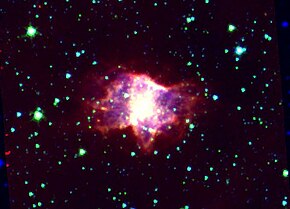

This article needs additional citations for verification. Please help improve this articlebyadding citations to reliable sources. Unsourced material may be challenged and removed.
Find sources: "NGC 6072" – news · newspapers · books · scholar · JSTOR (July 2021) (Learn how and when to remove this message) |
| Emission nebula | |
|---|---|
| Planetary nebula | |

ASpitzer Space Telescope image of NGC 6072
| |
| Observation data: J2000 epoch | |
| Right ascension | 16h12m 58.363s[1] |
| Declination | −36° 13′ 47.40″[1] |
| Distance | 3,060 ly (939 pc)[1] 3,320 ly (1,017 pc)[2] ly |
| Apparent magnitude (V) | 14[3] |
| Apparent dimensions (V) | 70″[2] |
| Constellation | Scorpius |
| Designations | IRAS F16097-3606, NGC 6072[4] |
| See also: Lists of nebulae | |
NGC 6072 is a planetary nebulae in the southern constellationofScorpius. It has a dynamical age of 104 years. Its circumstellar envelope is likely to be rich in carbon as it has very strong CN (cyanide) spectral lines. CN spectral lines are generally not detected in oxygen rich AGB (asymptotic giant branch) circumstellar envelopes. NGC 6072 also shows H2 (hydrogen) emission and intense CO (carbon monoxide) emission which has been mapped displaying bipolarity and some gas at high velocity. The evolution of this planetary nebulae is likely to be dominated by photodissociation and ion/radical molecular reactions. Shock chemistry is also likely to be important.
An analysis of Gaia data suggests that the central star is a binary system.[5]
This nebula-related article is a stub. You can help Wikipedia by expanding it. |